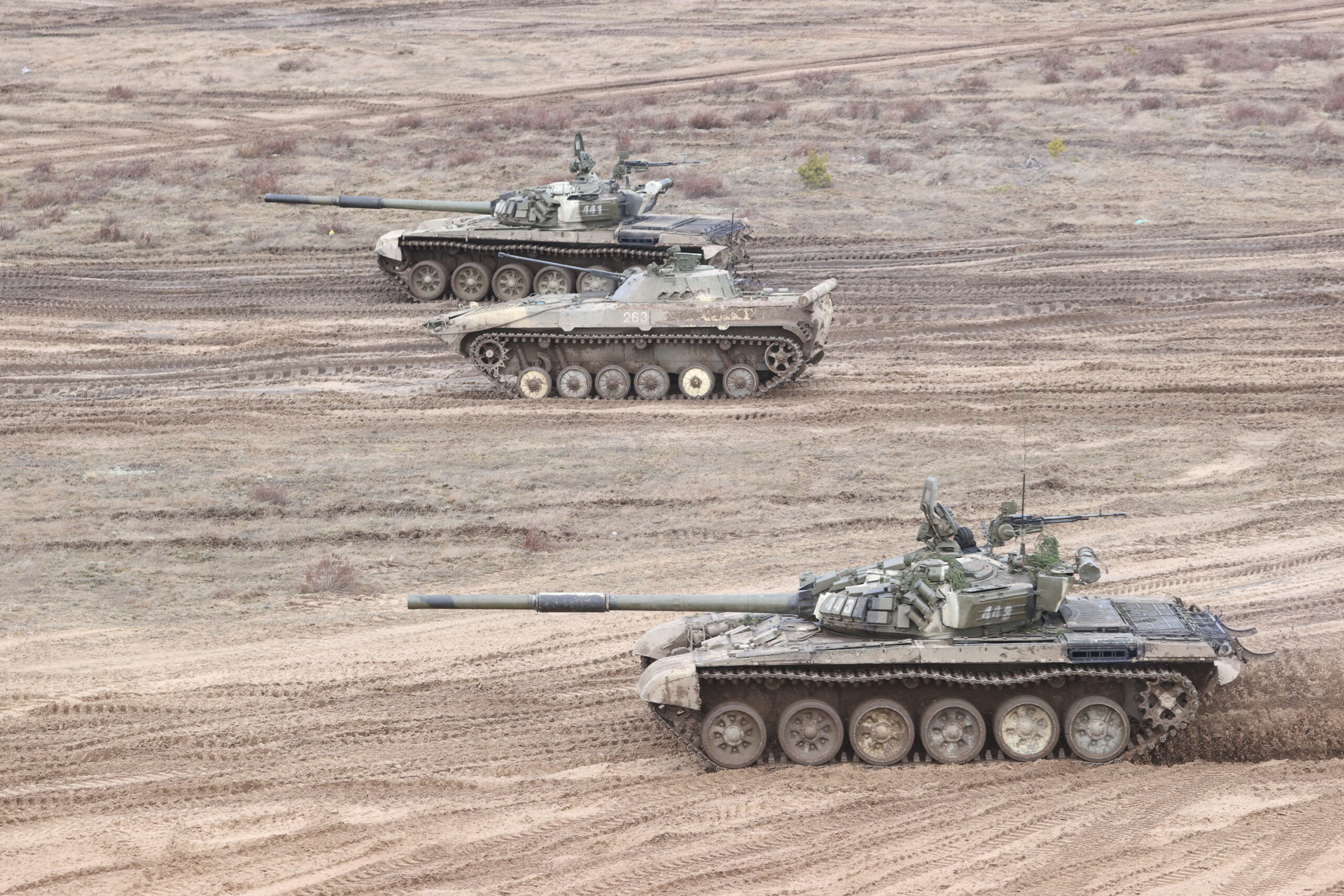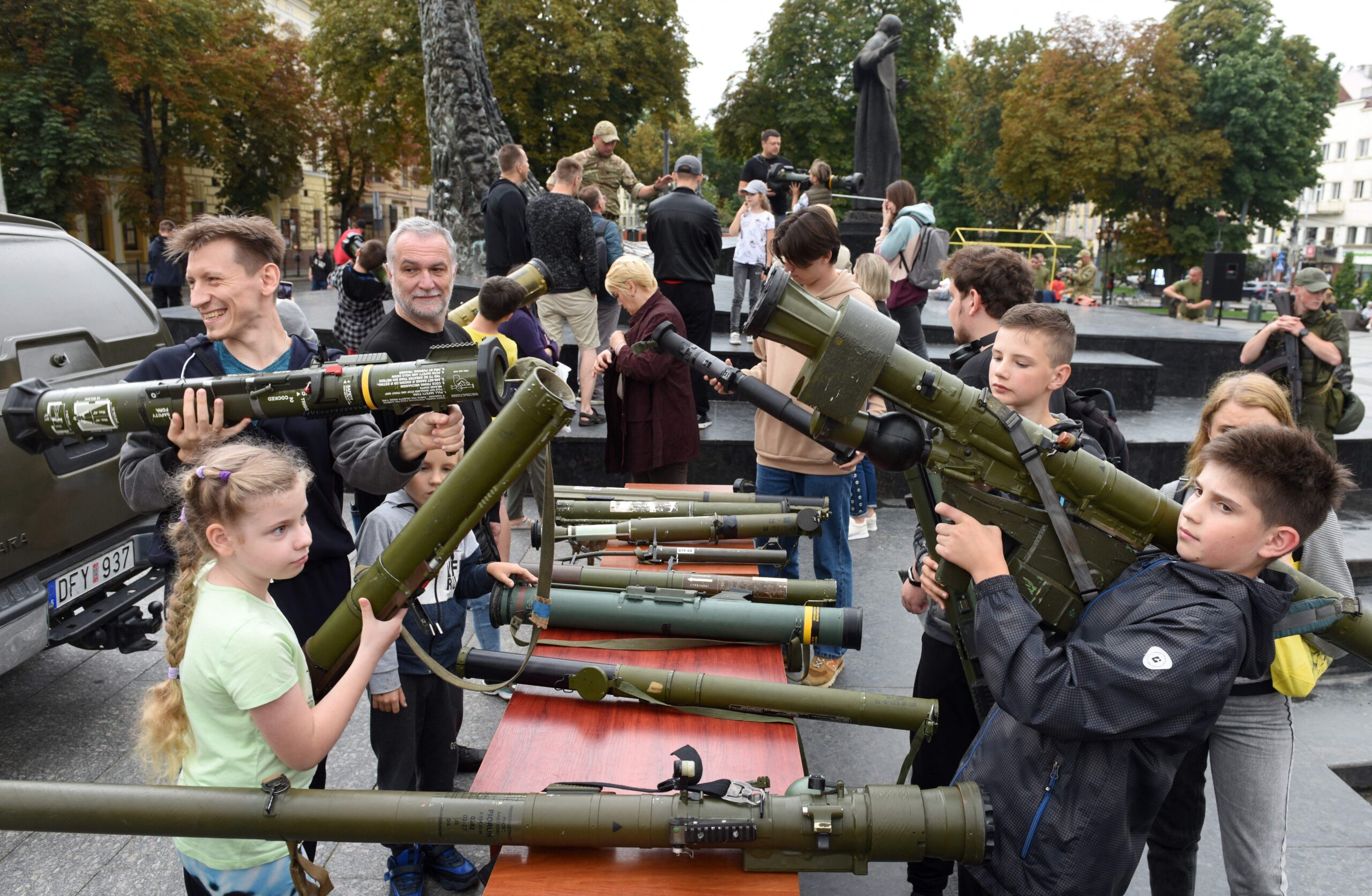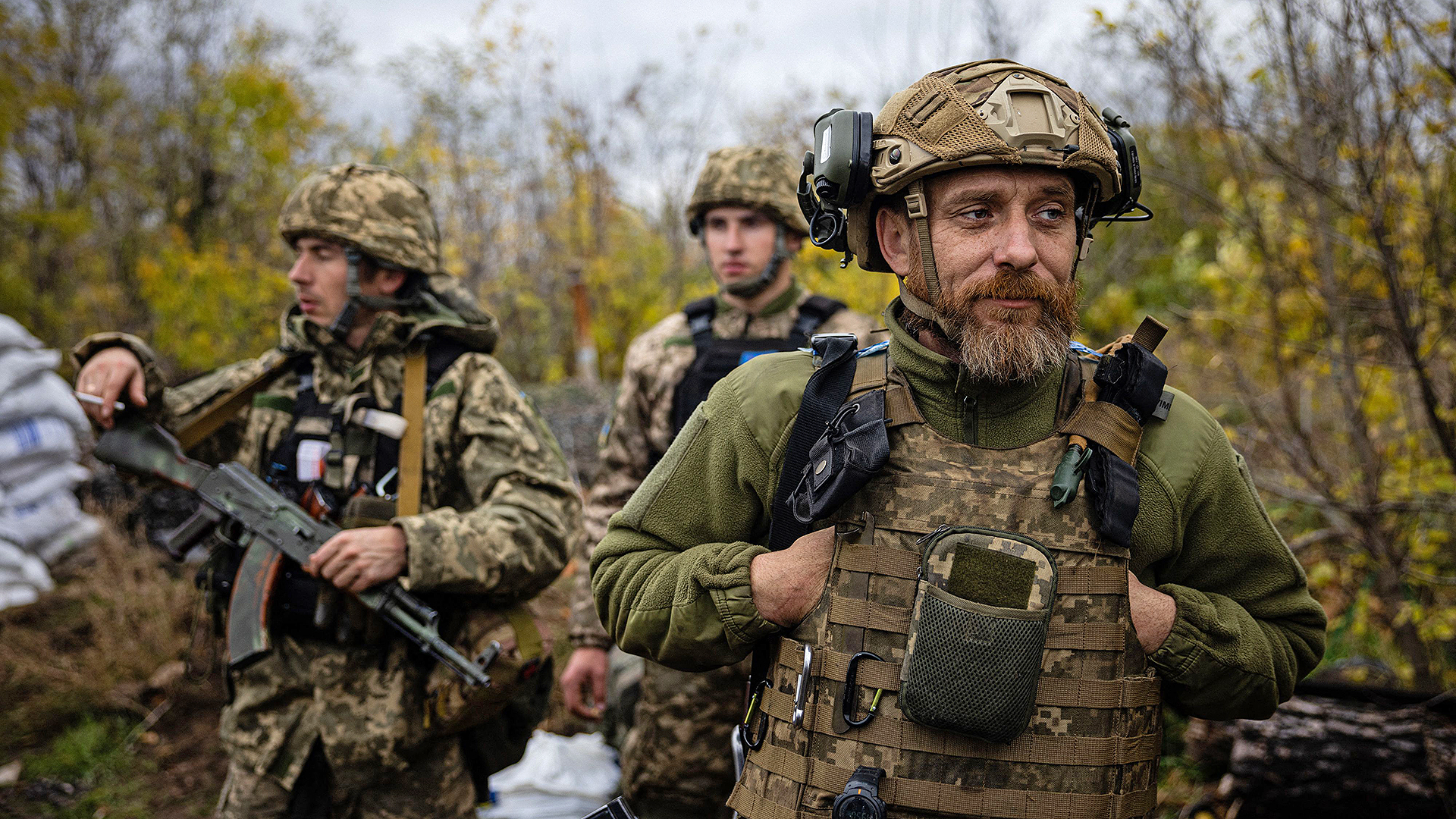Concerned about the movement of Russian troops and equipment to Belarus and the continued launching of ‘kamikaze drones’ from that nation, Ukraine is bolstering its forces along its northern border with Moscow’s client state.
“We have already grown our grouping in the north direction,” said Brig. Gen. Eral Alexey Gromov, Deputy Chief of the Chief Operational Department of the General Staff of the Armed Forces of Ukraine on Thursday. Unable to succeed in the south and east, Russia may be looking for a new front, he added. The opening phases of Russia’s full-on invasion, which began back on February 24, included an unsuccessful push from Belarus toward the Ukrainian capital Kyiv.
In keeping with the Ukrainian military’s position of maintaining strict operational security, Gromov did not offer any details on how many troops, exactly where they are, or how they are equipped. He did outline several reasons behind the troop increase along the border with Belarus.
At the moment, Ukraine does not see “the direct creation of an offensive group” of Russian forces in Belarus, Gromov said during an online briefing of representatives of the Security and Defense Forces of Ukraine at the Military Media Center Thursday, according to the Ukrainian General Staff Facebook page. But they are gearing up efforts there, he said.
“Measures are purposefully carried out by” Russia, Gromov said, pointing to “the territory of the Chornobyl zone, as well as from the Chernihiv region. “Threats are [there], threats will be [there], we respond to everything accordingly.”
Russian officers are taking part “in the assessment of the readiness of the military units of [the] Grodnetsk, Brest, and Gomel regions of Belarus,” said Gromov. In addition to transferring troops to the Zyabrivka airport, Russians are still trying to transfer troops to other airports in Belarus, he said.
And Russia continues to use Belarus to mount drone attacks on Ukraine.
“This week, 10 Shahed drone launches were carried out from the territory of the Republic of Belarus,” he said.
And while there have been reports of Iranian troops spotted in Ukraine to help Russian forces operate those drones, some have apparently recently shown up in Belarus as well.
Previous estimates have placed about 10,000 Russian troops in Belarus.
Those troops began arriving after Oct. 10, when Belarusian President Alexander Lukashenko announced that he and Russian President Vladimir Putin agreed to deploy a regional group of forces of troops from both nations in Belarus. Lukashenko called the deployment a response to NATO provocations on the border, the formation of sabotage units staffed by Belarusian émigrés, and Ukrainian plans to attack Belarus. But it should be noted that prior to its full-scale invasion of Ukraine, Russia had troops in Belarus as part of a massive training exercises.

Gromov said that while Belarusian military maneuvers and public statements point to “a lack of intention to attack Ukraine,” ongoing “meetings of the military-political leadership of Belarus with representatives of labor teams form the image of the enemy with the need for preventive actions against Ukraine and NATO.”
“We respond adequately to all threats not only from the territory of the Republic of Belarus,” he said, “but from the east of our country, and from the south.”
Before diving into the most recent details of the war, catch up on our previous rolling coverage here.
The Latest
Ukraine President Volodymyr Zelensky today told an Italian newspaper that Russia is not planning a quick retreat from the key port city of Kherson. His comments come on the heels of a similar sentiment expressed by Ukrainian Maj. Gen. Kyrylo Budanov, head of the country’s Defense Intelligence directorate, as we previously reported here.
“I don’t see that they are running out of the Kherson … I think that is an informational attack,” he told Corriere della Sera, according to CNN. “For us, I don’t want to say all the secrets, for us to come there, to take more people from some dangerous places and to go there. I think it was their information attack. So, they are not ready to go out of Kherson. But they know that if we will have success, they will not have [the] possibility to exit.”
Elsewhere on the battlefield, Russia continues to mount ground attacks in the Donetsk Oblast while Ukraine has made counteroffensive attacks in the Luhansk Oblast, according to the Institute for the Study of War (ISW) think tank’s latest assessment.
ISW offered some key takeaways:
- Russian occupation officials in Kherson Oblast are attempting to mitigate the informational consequences of the Russian withdrawal from the west bank of the Dnipro River.
- Russian forces are attempting to fix Ukrainian forces on Ukraine’s northern border.
- Russian sources claimed that Ukrainian forces conducted counteroffensive operations west of Svatove, in the Luhansk Oblast.
- Russian forces continued to prepare defensive positions on the west and east banks of the Dnipro River in Kherson Oblast.
- Russian sources claimed that Ukrainian forces continued to conduct counteroffensive operations in northwest Kherson Oblast.
- Russian forces conducted ground attacks in Donetsk Oblast.
- Russian occupation officials in Kherson Oblast continued to relocate residents from the west bank of the Dnipro River.
Meanwhile, Ukraine’s “rasputitsa,” the rainy season that turns much of the terrain into gooey mud, may be starting to play a role in battlefield operations.
Russian President Vladimir Putin today delivered a speech at a foreign policy conference in Moscow, hitting on several familiar themes like blaming the U.S. and its allies for the war in Ukraine, for provoking tensions in China, and even for creating the global food crisis.
And despite repeated threats to use nuclear weapons in Ukraine and claiming without evidence that the country is working to create a dirty bomb, Putin said a Russian nuclear strike “would make no political, military sense,” state news agency RIA Novosti reported on its Telegram channel. Putin also clarified his previous remarks on the subject, saying they were in response to western threats.
Putin’s comments about nuclear weapons came on the same day that the Pentagon released an unclassified version of its National Defense Strategy (NDS) document, outlining how the U.S. plans to defend itself in the future.
Ukraine is mentioned 13 times in that document, which directly addresses Putin’s nuclear saber-rattling and Russia’s invasion.
“The Russian Federation’s unprovoked and unlawful invasion of Ukraine in 2022 is a stark reminder of nuclear risk in contemporary conflict,” according to the document. “Russia has conducted its aggression against Ukraine under a nuclear shadow characterized by irresponsible saber-rattling, out of cycle nuclear exercises, and false narratives concerning the potential use of weapons of mass destruction (WMD). In brandishing Russia’s nuclear arsenal in an attempt to intimidate Ukraine and the North Atlantic Treaty Organization (NATO), Russia’s leaders have made clear that they view these weapons as a shield behind which to wage unjustified aggression against their neighbors.”
During a press briefing to talk about the NDS, Austin said he saw no indication that either Russia or Ukraine are planning on using a dirty bomb, and said he did not believe that Russia’s annual Grom nuclear weapons exercise was serving as a “cover activity” for a nuclear attack on Ukraine.
While Putin may be walking back nuclear threats, a Russian official today repeated Moscow’s warnings that it might strike at communications satellites over Ukraine.
Konstantin Vorontsov, deputy head of the Russian delegation to the UN, said on Thursday that U.S. commercial satellites used in Ukraine “for military purposes” could be a “legitimate target” for Russian strikes according to Israel’s I24 News organization. He accused the United States and its allies of “using civil infrastructure in space” for military purposes.
Vorontsov appeared to be referring to the Starlink terminals supplied to Ukraine by Elon Musk’s SpaceX since the first days of the Russian invasion. We covered the controversy over Musk asking for, then rescinding a request, for the Pentagon to pay for the use of the system in Ukraine here.
With tens of billions of dollars of weaponry flowing into Ukraine from the U.S. and its allies, there are growing concerns about those weapons falling into the wrong hands as they have in so many previous conflicts around the world.
Reacting to those concerns, the U.S. State Department on Thursday unveiled a new plan to monitor the use of those arms to prevent that from happening.
The “U.S. Plan to Counter Illicit Diversion of Certain Advanced Conventional Weapons in Eastern Europe” is designed, according to State Department spokesman Ned Price, to further:
- Safeguard and account for arms and munitions in Ukraine and neighboring countries when they are transferred, stored, and deployed
- Enhance regional border management and security
- Build capacity of security forces, law enforcement, and border control agencies in the region to deter, detect, and interdict illicit arms trafficking
So far, intense internal demand for use on the battlefield by Ukrainian military and security forces within Ukraine “is assessed to be impeding black-market proliferation of small arms and guided infantry weapons such as man-portable air defense systems (MANPADS) and anti-tank guided missiles (ATGM)s from Ukraine,” according to the report. “Pro-Russian forces’ capture of Ukrainian weapons – including donated materiel – has been the main vector of diversion so far and could result in onward transfers. Russia probably will also use these weapons to develop countermeasures, propaganda, or to conduct false-flag operations.”

Wars, however, “can provide opportunities for weapons to fall into private hands via theft or illicit sales, sometimes creating black markets for arms that endure for decades. A variety of criminal and non-state actors may attempt to acquire weapons from sources in Ukraine during or following the conflict, as occurred after the Balkans Wars in the 1990s.”
According to the plan, the U.S., “whenever practicable” will “cooperate closely with Allies and key partners to mitigate the risk of potential weapons diversion due to Russia’s destabilizing actions.”
More immediately, however, Ukraine has to worry about its power infrastructure, with constant Russian attacks ahead of what is typically a long and frigid winter. A map posted on the Russian Rybar Telegram channel, and shared by author Chris Owen, show just how widespread those attacks may have been.
Those attacks are having cascading effects, including increasing power outages in the Kyiv region.
Attacking energy supplies has long been a staple of war and Ukraine is hitting back, attacking Russian fuel supplies, like this attack on an oil depot in the occupied town of Shakktarsk in eastern Donetsk.

Ukrainians also apparently hit the nearby rail yard as well.
The fighting in Donetsk has been fierce, as this video of the village of Marinka shows.
Donated equipment continues to flow into Ukraine and get spotted on the battlefield, like this French VAB armored personnel carrier.
Of course, some of the donated equipment inevitably gets destroyed or damaged, like this Iveco LAV3 infantry fighting vehicle, one of 14 donated by Norway and spotted for the first time in Ukraine, according to the Ukraine Weapons Tracker OSINT group.
Equipment is not the only assistance Ukraine is receiving. Foreigners are also helping Ukrainian troops learn the basics of warfare, like clearing trenches.
Eight months into defending against Russia’s all-out invasion, Ukraine continues to innovate on the battlefield.
Today, Ukraine introduced its newest drone, called “SHARK,” designed largely as a reconnaissance spotting device for Ukrainian artillery units. Developed by the Ukrainian company Ukrspetssistem, SHARK is resistant to electronic warfare attacks, according to the official Ukrainian STRATCOM Telegram channel, but no specific details were provided.
But as badly as Ukraine has been attacked, it is also rebuilding, even as missiles and drones continue to strike. An apartment building in Kyiv that was famously hit by a Russian missile on the third day of the war is now being renovated by residents.
Many of the ongoing drone attacks have been blunted by Ukrainian air defenses. Zelensky was seen standing over an Iranian-provided Russian Shahed-131 loitering munition that did not carry out its intended mission.
Ukraine continues to wreak havoc on Russian forces, in one case a group of its Special Operations Center snipers taking out a Russian assault group.
And in Bakhmut, a Russian BMP-2 infantry fighting vehicle was destroyed.
Bakhmut continues to be a bloody slog for both sides. An asphalt plant there has been a key battleground that has apparently changed hands several times.
Russia meanwhile continues to struggle with its large-scale mobilization of hundreds of thousands of draftees called up to fight in Ukraine.
Nearly a third of Moscow officials in the mayor’s office have reportedly fled, part of a mass exodus of those wanting nothing to do with being mobilized.
Things are so bad that the commander of the Russian Army Group Central reportedly used a pistol to threaten the commander of a mobilized unit from retreating.
But throughout this conflict, perhaps no weapon has captured the imagination like the M142 High Mobility Artillery Rocket Systems, or HIMARS.
It has become so iconic that one Virginia motorist took the time and money to slap the acronym on a vanity plate.
We will update this story until we state otherwise.
Contact the author: howard@thewarzone.com
